Resources by Bernadette McNary-Zak
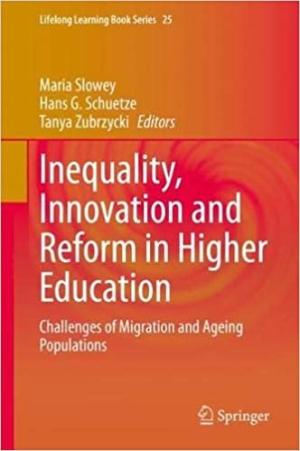
An important backdrop to the achievement of the Millennium Development Goals involves consideration of the impact of a ‘new demographics’ derived from the interaction of two global developments. First, high levels of internal and cross-border mass migration, stimulated by climate change, violence and disparities in wealth and social stability within and between different countries and the global South and North. Second, the phenomenon of increasing longevity and rapidly ageing populations, especially in the developed world. This book explores the central role that socially engaged higher education might potentially play in helping address these challenges, enhancing lifelong learning opportunities and facilitating more positive outcomes for both individuals and societies. The contributors to this book are scholars of higher education and lifelong learning based in twelve countries from Europe (Germany, Ireland, Slovenia, Sweden and the United Kingdom), the Americas (Brazil, Canada, Mexico and the USA), Japan, Australia and New Zealand. (From the Publisher)
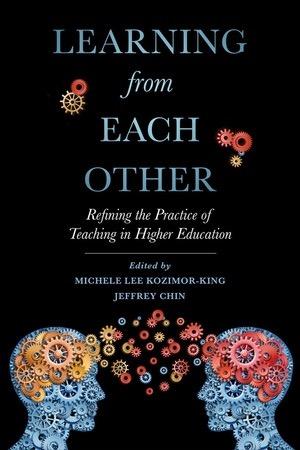
As faculty seek more effective learning and teaching practices, several disciplines have taken a “turn to reflective pedagogy” in recent years. Learning from Each Other: Refining the Practice of Teaching in Higher Education makes a substantive contribution to pedagogical practice in the discipline of sociology; this book is the result of workshops sponsored by the international honor society for the discipline. Contributors reflect a wide range of institutional types, teaching contexts, and research areas. Following a brief introduction by the editors, the book is divided neatly into four parts: curricular innovations, classroom techniques, out-of-class situations, and assessment. Each chapter treats theory and strategy; this combination assures that topics are discussed with sufficient depth and adequate breadth of coverage across the discipline. References are included at the end of each chapter and the book closes with a useful index. Four of the twenty-one chapters in this book will be given attention here. “Courting Controversy and Allowing for Awkward: Strategies for Teaching Difficult Topics,” by Mari Plikuhn, offers sound guidance applicable to any number of classroom discussions and contexts. The chapter addresses controversial content as well as classroom space; it includes helpful strategies for class structure and management. In “Becoming a Culturally Inclusive Educator,” Dena R. Samuels provides a guided sequence of practical steps for faculty engagement in this “transformative process” (203). The reader is encouraged to consider carefully the question of preparedness before working through the eight steps in this process. “The Value of Games and Simulations in the Social Sciences,” by Amanda M. Rosen, assesses the use of this active-learning strategy in a clear way. Rosen weighs barriers and incentives before addressing best practices. Finally, “Putting the Student at the Center: Contemplative Practices as Classroom Pedagogy,” by Tracey Wenger Sadd, supplies a succinct discussion of goals, outcomes, practices, and assessment of contemplative pedagogy. The chapter concludes with considerations and questions for determining the application of this pedagogy. Instructors in Religious Studies and Theology are fortunate that these disciplines are strong in SOTL (scholarship of teaching and learning). These disciplines have a robust infrastructure for engaging in workshops, colloquies, and grant work to strengthen critical reflection on pedagogy. It is telling that instructors in these disciplines continue to produce and contribute highly impactful work on pedagogical research and practice that informs the national discourse. For this reason, there is much to be gained from this book. Discrete chapters may arouse interest in current trends, common questions, and shared efforts. Furthermore, attention to alternative perspectives on recurrent challenges and concerns distinct to a discipline can raise awareness. Finally, the recognition that higher education is growing ever more interdisciplinary makes this an opportune time to reflect on learning and teaching as a collaborative enterprise.
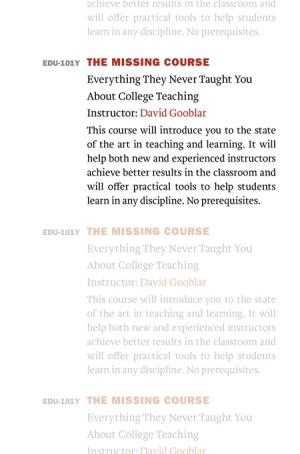
Professors know a lot, but they are rarely taught how to teach. The author of the Chronicle of Higher Education’s popular “Pedagogy Unbound” column explains everything you need to know to be a successful college instructor. College is changing, but the way we train academics is not. Most professors are still trained to be researchers first and teachers a distant second, even as scholars are increasingly expected to excel in the classroom. There has been a revolution in teaching and learning over the past generation, and we now have a whole new understanding of how the brain works and how students learn. But most academics have neither the time nor the resources to catch up to the latest research or train themselves to be excellent teachers. The Missing Course offers scholars at all levels a field guide to the state of the art in teaching and learning and is packed with invaluable insights to help students learn in any discipline. Wary of the folk wisdom of the faculty lounge, David Gooblar builds his lessons on the newest findings and years of experience. From active-learning strategies to course design to getting students talking, The Missing Course walks you through the fundamentals of the student-centered classroom, one in which the measure of success is not how well you lecture but how much students learn. Along the way, readers will find ideas and tips they can use in their classrooms right away. (From the Publisher)

Organization and Newness: Discourses and Ecologies of Innovation in the Creative University offers a view from a perspective of organizational education on the ‘new’, which analyzes the production of the ‘new’ within organizations, in relation to the inherent learning processes. Fundamental for this perspective is the question about the changeability of organizations, especially when these are not viewed only as instrumentally established regulatory structures but rather as social constructs. The contributions of this volume contour the complexity of newness in organization and form a bridge from critical analysis of imperative discourse of newness, to programmatic pleas of an organizational pedagogy, which is normative in nature, for a reconfiguration of organizational and societal relationships. The issue at hand shows how tightly the question about newness is constitutively woven into the self-conception of organizational education and pedagogy. (From the Publisher)
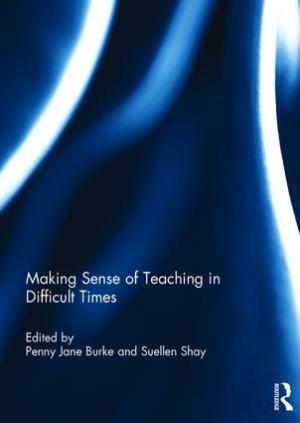
The ten chapters in this volume first appeared as a special issue of Teaching in Higher Education (2013). Each author is situated in particular classroom and institutional contexts ranging from South Africa to Australia, from Denmark to China and Canada, from the United Kingdom to the United States. Their expertise is far reaching. Although none of the contributors are in the areas of theology or religious studies, the questions raised and addressed in this volume center on strategies for effective teaching and learning. Collectively, these chapters supply a snapshot of the challenges and promises facing instructors of higher education. As a result, there are several potentially relevant sites for reflection and application. Grouped thematically, student-centered chapters highlight raising awareness of White Privilege (chapter 1) and of global citizenship through on-campus threshold-crossing experiences (chapter 3), undergraduate research (chapter 4), and social justice (chapter 8). More instructor-centered chapters confront the role of self-reflective practices (chapter 2), and of online education (chapter 10). Curricular chapters focus on inter-disciplinarity in an engineering curriculum (chapter 5), on the impact of problem-based learning on Chinese students undertaking higher education outside of their homeland (chapter 6), and on assessment practices (chapter 9). Of all of the chapters in this volume, “Reframing teaching relationships: from student-centered to subject-centered teaching,” would be the most suitable starting point for the reader of the Wabash Center’s online reviews. Although this chapter is situated at the center of the volume (chapter 7), it serves as the organizing chapter because it tackles an issue raised more specifically in the other chapters. Employing frame theory, the authors respond to questions of self-identity and the teaching relationship by advocating subject-centered learning. The strength of the volume rests with the particular contribution of each individual chapter. Offering a specific perspective in a local context, each author works within cleanly defined theoretical boundaries and approaches, and presents an argument worthy of further consideration and discussion. Despite this strength, however, the overall coherence of the volume suffers from the lack of a formal, introductory chapter and a final, concluding chapter. An additional chapter at the fore could justify the order of presentation of the collection (thematically topically, or through some other means) and facilitate the act of reading by explaining criteria for selection and inclusion; a closing chapter might indicate possible applications of the issues in other contexts and introduce new approaches or questions moving forward. The lack of these critical organizing chapters at the opening and closing of the volume requires the reader to determine the contours of coherence across the chapters and to impose frameworks for interpretation.
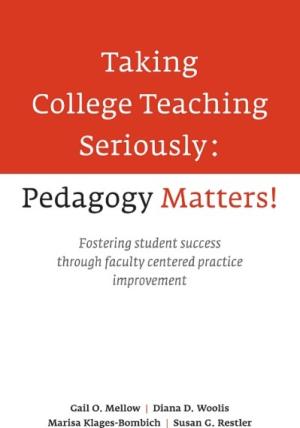
The Global Skills for College Completion (GSCC) initiative, funded by the Bill and Melinda Gates Foundation, is one of many efforts targeting the advancement of community college students, faculty, and institutions across the United States. Faculty selected to participate in the initiative taught developmental courses, documenting and analyzing pedagogical practices using Web 2.0 tools in order to facilitate communication and collaboration around teaching and learning. Regular and consistent forms of peer feedback, coaching, and reflection required participants to learn with, and from, one another. Primarily intended for college instructors, Taking College Teaching Seriously promises to broaden the impact of their faculty practice improvement model by encouraging the application of these processes by instructors of all types of courses in all institutional contexts of higher education. The value of this book for faculty lies in its accessibility and in its applicability: any faculty member, or group of faculty members of the same institution or across institutions, can easily replicate one or more of the processes described and explained in this book and so heighten their potential for acquiring some of the lessons learned. Although there are many useful components in this engaging book, it should be recognized that in the larger context of scholarship on teaching and learning the book contributes to that body of work focused on the significance of reflection as a faculty practice. While faculty assessment is a built-in feature of college courses through peer visits and course evaluations, and a standard requirement in faculty review processes over the course of a career, faculty reflection on teaching and learning is often underemphasized and much less institutionalized. Furthermore, when faculty reflection on teaching and learning does occur, it often is an isolated practice intended to address a particular issue or recurring problem experienced in a specific course. However, the movement toward institutionalizing faculty reflection practices appears to be growing steadily and assuming a variety of forms. One form highlighted in this book is the formation of an online community of practice (24-26). Put simply, a community of practice typically serves a small group of faculty with a shared interest who agree to organize themselves around work on a common issue or goal. In some cases, the formation of a community of practice may be connected to teaching and learning initiatives at a particular institution. However, as technological practices continue to become more embedded in college curricula and teaching, the design and implementation of online communities of practice may prove more practical and more beneficial to faculty development and support. Furthermore, communities of practice may transcend disciplinary boundaries; while the faculty participating in this initiative had primary expertise in mathematics and English, such practice readily extends to those in other disciplines as well.